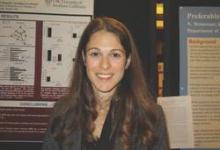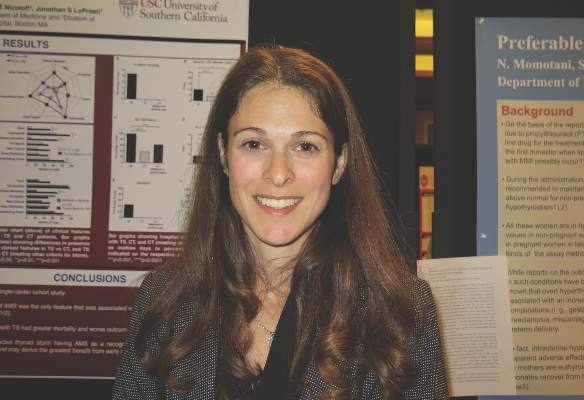User login
CORONADO, CALIF. – The presence of an altered mental state was the only feature associated with the clinical diagnosis of thyroid storm, compared with patients who had compensated thyrotoxicosis, results from a retrospective study demonstrated.
“Thyroid storm is a rare diagnosis, but it’s something that can cause mortality [of] 10% or more,” lead study author Dr. Melissa G. Lechner said in an interview during the annual meeting of the American Thyroid Association. “Though the existing Burch-Wartofsky (Endocrinol. Metab. Clin. North Am. 1993;22:263-77) and Akamizu (Thyroid 2012;22:661-79) scoring systems can help guide clinicians in the diagnosis of thyroid storm, they have not been applied to inpatient populations,” said Dr. Lechner, who is an internal medicine resident at Brigham and Women’s Faulkner Hospital, Boston. “Our question was, in an inpatient setting, and among patients who are acutely ill, how do you distinguish the patients who are hyperthyroid and going to have bad outcomes from the patient who just has sepsis and hyperthyroidism? Who do we need to be aware of in terms of being aggressive with treatment?”
To find out, she and her associates retrospectively evaluated the records of 150 patients who were admitted at Los Angeles County–University of Southern California Medical Center between Jan. 1, 2008 and Dec. 31, 2013, with a thyroid-stimulating hormone (TSH) level of less than .01 mIU/L. They evaluated patients with thyroid storm and those with compensated thyrotoxicosis for differences in clinical and laboratory characteristics, and in hospital outcomes of inpatient mortality, hospital length of stay, ICU admission, ICU length of stay, intubation, and duration of mechanical ventilation. Patients were retrospectively categorized by Burch-Wartofsky score (BWS less than 25, 25-44, or 45 and greater) and Akamizu categories (AkTS1/2). They excluded non-thyrotoxic causes of TSH suppression and those with inadequate medical records.
The researchers found that the following clinical features helped to differentiate thyroid storm from compensated thyrotoxicosis in the clinical hospital setting: fever of greater than 100.4 degrees F, heart rate of greater than 100 beats per minute, altered mentation, and precipitating event (P less than .05 for all). Altered mentation was the was only clinical feature that distinguished thyroid storm from compensated thyrotoxicosis for patients with a BWS score of greater than 45 and in patients with AkTS1/2 (P less than .001). In addition, patients diagnosed with thyroid storm had greater mortality and worse outcomes over all measures. The findings “have been useful, especially from an internal medicine perspective, because often we’re the first to see these patients,” noted Dr. Lechner, who began the study while a medical student at USC.
She and her associates concluded that patients with suspected thyroid storm who have altered mental state as a recognized feature may be at greater risk for adverse outcomes and may derive the greatest benefit from early and/or aggressive therapeutic intervention.
Dr. Lechner reported having no financial disclosures.
On Twitter @dougbrunk
CORONADO, CALIF. – The presence of an altered mental state was the only feature associated with the clinical diagnosis of thyroid storm, compared with patients who had compensated thyrotoxicosis, results from a retrospective study demonstrated.
“Thyroid storm is a rare diagnosis, but it’s something that can cause mortality [of] 10% or more,” lead study author Dr. Melissa G. Lechner said in an interview during the annual meeting of the American Thyroid Association. “Though the existing Burch-Wartofsky (Endocrinol. Metab. Clin. North Am. 1993;22:263-77) and Akamizu (Thyroid 2012;22:661-79) scoring systems can help guide clinicians in the diagnosis of thyroid storm, they have not been applied to inpatient populations,” said Dr. Lechner, who is an internal medicine resident at Brigham and Women’s Faulkner Hospital, Boston. “Our question was, in an inpatient setting, and among patients who are acutely ill, how do you distinguish the patients who are hyperthyroid and going to have bad outcomes from the patient who just has sepsis and hyperthyroidism? Who do we need to be aware of in terms of being aggressive with treatment?”
To find out, she and her associates retrospectively evaluated the records of 150 patients who were admitted at Los Angeles County–University of Southern California Medical Center between Jan. 1, 2008 and Dec. 31, 2013, with a thyroid-stimulating hormone (TSH) level of less than .01 mIU/L. They evaluated patients with thyroid storm and those with compensated thyrotoxicosis for differences in clinical and laboratory characteristics, and in hospital outcomes of inpatient mortality, hospital length of stay, ICU admission, ICU length of stay, intubation, and duration of mechanical ventilation. Patients were retrospectively categorized by Burch-Wartofsky score (BWS less than 25, 25-44, or 45 and greater) and Akamizu categories (AkTS1/2). They excluded non-thyrotoxic causes of TSH suppression and those with inadequate medical records.
The researchers found that the following clinical features helped to differentiate thyroid storm from compensated thyrotoxicosis in the clinical hospital setting: fever of greater than 100.4 degrees F, heart rate of greater than 100 beats per minute, altered mentation, and precipitating event (P less than .05 for all). Altered mentation was the was only clinical feature that distinguished thyroid storm from compensated thyrotoxicosis for patients with a BWS score of greater than 45 and in patients with AkTS1/2 (P less than .001). In addition, patients diagnosed with thyroid storm had greater mortality and worse outcomes over all measures. The findings “have been useful, especially from an internal medicine perspective, because often we’re the first to see these patients,” noted Dr. Lechner, who began the study while a medical student at USC.
She and her associates concluded that patients with suspected thyroid storm who have altered mental state as a recognized feature may be at greater risk for adverse outcomes and may derive the greatest benefit from early and/or aggressive therapeutic intervention.
Dr. Lechner reported having no financial disclosures.
On Twitter @dougbrunk
CORONADO, CALIF. – The presence of an altered mental state was the only feature associated with the clinical diagnosis of thyroid storm, compared with patients who had compensated thyrotoxicosis, results from a retrospective study demonstrated.
“Thyroid storm is a rare diagnosis, but it’s something that can cause mortality [of] 10% or more,” lead study author Dr. Melissa G. Lechner said in an interview during the annual meeting of the American Thyroid Association. “Though the existing Burch-Wartofsky (Endocrinol. Metab. Clin. North Am. 1993;22:263-77) and Akamizu (Thyroid 2012;22:661-79) scoring systems can help guide clinicians in the diagnosis of thyroid storm, they have not been applied to inpatient populations,” said Dr. Lechner, who is an internal medicine resident at Brigham and Women’s Faulkner Hospital, Boston. “Our question was, in an inpatient setting, and among patients who are acutely ill, how do you distinguish the patients who are hyperthyroid and going to have bad outcomes from the patient who just has sepsis and hyperthyroidism? Who do we need to be aware of in terms of being aggressive with treatment?”
To find out, she and her associates retrospectively evaluated the records of 150 patients who were admitted at Los Angeles County–University of Southern California Medical Center between Jan. 1, 2008 and Dec. 31, 2013, with a thyroid-stimulating hormone (TSH) level of less than .01 mIU/L. They evaluated patients with thyroid storm and those with compensated thyrotoxicosis for differences in clinical and laboratory characteristics, and in hospital outcomes of inpatient mortality, hospital length of stay, ICU admission, ICU length of stay, intubation, and duration of mechanical ventilation. Patients were retrospectively categorized by Burch-Wartofsky score (BWS less than 25, 25-44, or 45 and greater) and Akamizu categories (AkTS1/2). They excluded non-thyrotoxic causes of TSH suppression and those with inadequate medical records.
The researchers found that the following clinical features helped to differentiate thyroid storm from compensated thyrotoxicosis in the clinical hospital setting: fever of greater than 100.4 degrees F, heart rate of greater than 100 beats per minute, altered mentation, and precipitating event (P less than .05 for all). Altered mentation was the was only clinical feature that distinguished thyroid storm from compensated thyrotoxicosis for patients with a BWS score of greater than 45 and in patients with AkTS1/2 (P less than .001). In addition, patients diagnosed with thyroid storm had greater mortality and worse outcomes over all measures. The findings “have been useful, especially from an internal medicine perspective, because often we’re the first to see these patients,” noted Dr. Lechner, who began the study while a medical student at USC.
She and her associates concluded that patients with suspected thyroid storm who have altered mental state as a recognized feature may be at greater risk for adverse outcomes and may derive the greatest benefit from early and/or aggressive therapeutic intervention.
Dr. Lechner reported having no financial disclosures.
On Twitter @dougbrunk
AT THE ATA ANNUAL MEETING
Key clinical point: Patients with suspected thyroid storm who present with an altered mental state should be treated aggressively.
Major finding: Altered mentation was the was only clinical feature that distinguished thyroid storm from compensated thyrotoxicosis for patients with a Burch-Wartofsky score of greater than 45 and in patients with thyroid storm grades 1 and 2 based on Akamizu criteria (P less than .001).
Data source: A retrospective review of 150 patients who were admitted at Los Angeles County-University of Southern California Medical Center between Jan. 1, 2008 and Dec. 31, 2013 with a TSH level of less than .01 mIU/L.
Disclosures: Dr. Lechner reported having no financial disclosures.

